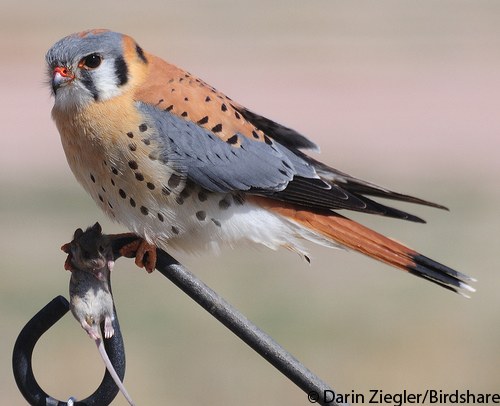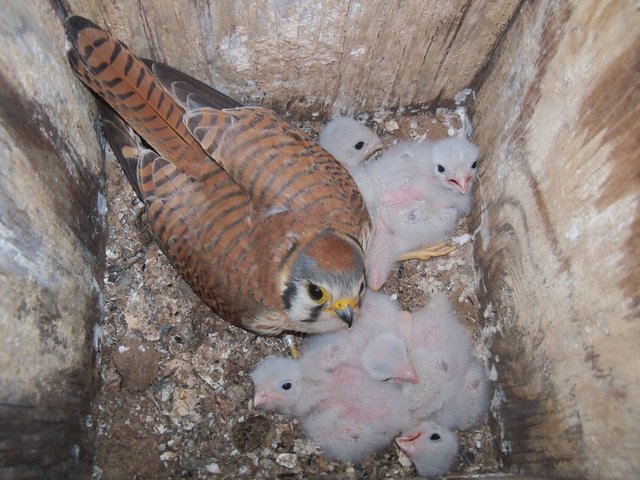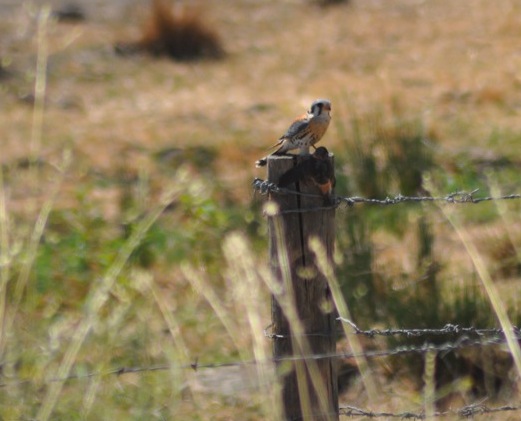The miles of barbed wire fences that criss-cross the Reserve’s 6,500 acres of open grasslands and vernal pools are ideal perches for falcons in search of prey. Our resident falcon, the American Kestrel, is often seen perched on fence posts, pumping its tail or hovering in the open, searching for insects and mice. American Kestrels populations are in decline across North America. This spring the Reserve initiated a project to expand their populations and to monitor their breeding productivity.
 The Kestrel is robin-sized, but has longer, more pointed wings. Up close you might see two black vertical lines on the face. In flight, the long, slender, pointed wings and long tail are characteristics they share with other falcon species. It may be commonly mistaken for a Prairie Falcon, the other falcon that occurs in this area. To recognize a kestrel, look for the bluish crown with the rufous (reddish) patch on top, the reddish tail and reddish breast and black spots on a white belly. Males are slightly smaller than females and have blue-gray wings with dark primary feathers. Females are reddish brown on the back, wings and tail. Their distinctive call is another clue that helps with identification -a loud, klee-klee-klee. Kestrels prefer open areas and are often seen perched on power poles or electrical lines throughout Merced and Mariposa counties. Look for them along the edge of campus, especially near grassy fields.
The Kestrel is robin-sized, but has longer, more pointed wings. Up close you might see two black vertical lines on the face. In flight, the long, slender, pointed wings and long tail are characteristics they share with other falcon species. It may be commonly mistaken for a Prairie Falcon, the other falcon that occurs in this area. To recognize a kestrel, look for the bluish crown with the rufous (reddish) patch on top, the reddish tail and reddish breast and black spots on a white belly. Males are slightly smaller than females and have blue-gray wings with dark primary feathers. Females are reddish brown on the back, wings and tail. Their distinctive call is another clue that helps with identification -a loud, klee-klee-klee. Kestrels prefer open areas and are often seen perched on power poles or electrical lines throughout Merced and Mariposa counties. Look for them along the edge of campus, especially near grassy fields.
The availability of trees with suitable natural cavities limits their breeding range. Fortunately they readily welcome artificial nest boxes as a suitable alternative to a hole in a tree. Across the country there is a concerted effort to provide artificial nest boxes for kestrels. A leader in this effort in California is Steve Simmons. He has built 100s of such boxes and he monitors them daily during the breeding season. Steve supervised the construction of the 10 nest boxes for the Reserve. In March our team of Reserve undergraduate volunteers diligently worked to erect these 10 specially crafted nest boxes. The boxes were strategically placed on fence posts in the Reserve. We were very excited when Kestrels used 6 of the 10 boxes, a high proportion according to Steve.
Table of Results from Nest Box project on the Reserve
| Nest Box # | No. Eggs | Chicks Banded | Adults Banded | Previously banded adults |
| KB 1 | 5 | 5 (1F & 4M) | 0 | 1 Female |
| KB 2 | 0 | 0 | 0 | 0 |
| KB 3 | 0 | 0 | 0 | 0 |
| KB 4 | 0 | 0 | 0 | 0 |
| KB 5 | 4 | 3 (2F & 1M) | 1 (F) | 0 |
| KB 6 | 2 | N/A | 0 | 0 |
| KB 7 | 2 | 2 | 0 | 0 |
| KB 8 | 4 | Missing Eggs | 1 (F) | 0 |
| KB 9 | 0 | 0 | 0 | 0 |
| KB10 | 5 | 5 | 2 (F & M) | 0 |
| Total 10 | 22 | 15 | 4 | 1 |
Breeding
The breeding season for kestrels begins around April and May and can extend into July for the second broods. If second broods are produced late in the season, they have a lower chance of survival. Occasionally small groups of kestrels gather together while the males set up their territory. They will defend against larger raptors like Red-tailed Hawks (Buteo jamaicensis). Typically monogamous, the male will begin transferring food to the female 4-5 weeks prior to laying and will continue until two weeks after chicks have hatched. The nest boxes we set up were lined with a bit of wood shavings to aid in hatchability of the eggs; they are just the right size for a typical clutch of four or five nestlings. We monitored the nest boxes to determine how many eggs were laid and we continued checking to determine the hatching date. The eggs are elliptical shaped with varied coloration from white to cream with overlaid blotches of rust colored browns. The female will lay one egg a day and she begins the 30-day incubation period upon laying the second to last egg. Prior to hatching, the chicks may peep as they prepare to emerge from the egg. It may take one or two days for a chick to hatch. The female helps the chicks burst through the eggshell and will consume the shells.

The young birds open their eyes fully by the third day and within a week their skin and talons develop color. By the second week, their plumage covers most of their body and they are large enough to be banded. Upon carefully opening the nest boxes some juveniles exhibit typical defense behavior of rolling on their back and presenting their talons while others expected to be fed. During the process of banding we determine their gender by examining the coloration of their primary flight feathers (blue in males and brown is female). If prey is scarce larger siblings will eat their weaker siblings.
During the first week the male is the primary food provider and thereafter the female will take the lead bringing in up to 40 items per day for at least 12 days. By the 30th day the young will depart their nest. But will stay close to the cavity as they are still dependent on the parents for food for another two weeks.
Juveniles will likely migrate in August depending on prey availability, some going as far as Mexico. Adults will depart breeding grounds after old flight-feathers are molted and new ones are grown.
Food Habits
Kestrels are diurnal predators. They prefer to hunt from a perch to preserve energy but will also hover-hunting. Once their prey is spotted, they bob their heads, wag their tail and use parallax vision to narrow the location of their prey. Their primary source of food on the Reserve is grasshoppers and other large insects, as well as small rodents such as mice and gophers. Kestrels derive water from their prey and they regurgitate pellets, which contain indigestible bones and exoskeletal parts. The uneaten remains of larger prey are sometimes hidden as surplus that is available during unfavorable conditions.
We have collected many regurgitated pellets and have identified grasshopper, rodent and bird remains in them. We have also observed a Kestrel with a Cliff Swallow in its talons. The Cliff Swallow got away but it was a close call!

Next time you are strolling along the edges of campus, keep your eyes on the sky and you will be certain to spy a kestrel swooping along or perched as it searches for prey in the grass and on the ground.


